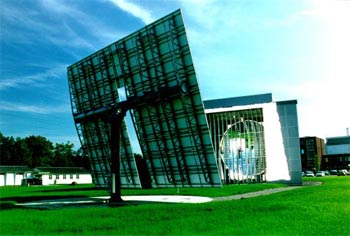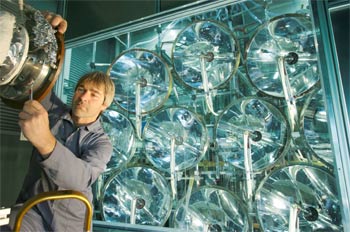Name of infrastructure: Solar Technologies Laboratory, Paul Scherrer Institute (PSI)
Location (town, country): Villigen, Switzerland
Legal name of organisation operating the infrastructure: Paul Scherrer Institut
The Paul Scherrer Institute (PSI) is a multi-disciplinary research centre for natural sciences and technology. The PSI is active in solid-state physics, materials sciences, elementary particle physics, life sciences, nuclear and non-nuclear energy research, and energy-related ecology.
The Solar Technologies Laboratory, at the Paul Scherrer Institute (PSI) in Switzerland currently has two major state-of-the-art facilities available for concentrated solar research, a high-flux solar furnace (HFSF) and a high-flux solar simulator (HFSS) described below. The facilities are primarily used for investigating high temperature solar thermo-chemical processes that are part of novel thermodynamic cycles designed to produce renewable energy carriers. Support infrastructure for the solar furnace and simulator include a sophisticated data acquisition system, state-of-the-art online gas analyses, x-ray diffraction and thermo gravimeters.
The infrastructure is situated at PSI. It is a multidisciplinary research centre focusing on the natural sciences and technologies; it is the largest national research institution in the Swiss Federal Institute of Technology (ETH).
The facilities offered for solar research at PSI are:

High-Flux Solar Furnace (HFSF): The HFSF is capable of delivering up to 40 kW at a peak concentration ratio of 5000 suns (1 sun = 1 kW/m2) which produces temperatures of up to 2500 K. higher concentrations are attainable by using the secondary concentrator.
The parabolic concentrator is housed in a 13-m high room which shelters it from adverse weather conditions. Large doors are opened for the experiments and reflected sunlight from the heliostat is allowed to impinge directly upon the concentrator. Vertical Venetian-blind-type shutters installed over the opening regulate the intensity of solar radiation incident upon the concentrator, thus, affording control over the amount of solar flux. Experiments are run from an adjacent room looking onto the solar furnace that contains all of the necessary controls for the heliostat, reactors/receiver platforms, shutters, equipment, and data acquisitions systems.
The parabolic concentrator has a diameter and focal length of 8.5 m and 5.13 m, respectively. Hence, the aperture ratio is 1.66 and the rim angle is 45°. The primary component of the apparatus is a 0.27‑mmthick stretched-steel membrane parabola. 0.52 × 0.36 m rectangular thin-glass mirrors with 92% reflectivity are mounted over the membrane. The concentrator is positioned vertically.
The concentrated solar flux is quantified optically by a digital CCD camera calibrated with an absolute point radiometer that records the image on a water-cooled plate in the focal plane with a ±10% error. The alumina-coated plate reflects diffusely and can be approximated as a Lambertian target.
Typical radioative power inputs into a 60‑mm diameter aperture in the HFSF are in the range of 5-10 kW.

High-Flux Solar Simulator (HFSS): The HFSS was constructed using an array of 10 xenon arc lamps. This indoor facility was commissioned late in 2005 and is capable of delivering over 50kW of radiative power at peak fluxes that exceed 11,000 suns (11MW/m2). The simulator closely approximates the radiative heat transfer characteristics of solar towers and furnaces and was the first of its kind to be constructed in Europe. Experiments are monitored from an adjacent room overlooking the simulator. The xenon arc lamps are positioned to concentrate the radiative power into the aperture of a solar reactor. The total available radiative power over a 60‑mm diameter aperture is about 20 kW which is nearly equivalent to an average of 6,800 suns (6.8 MW/m2); this corresponds to a stagnation temperature of more than 3300 K.
The simulated solar flux is measured using a digital CCD camera to record the image on a water-cooled plate in the focal plane similar to the solar furnace. A calorimeter is also available for more accurate input flux measurement. The xenon arc lamps can be switched on and off individually and the input power adjusted for varying the radiative heat transfer into the reactor.
The solar simulator is a unique facility that allows much more flexibility and control over experiments. The simulator is ideal for attaining reproducible results and examining various facets of solar processes.
For further information on these facilities, visit the web site
solar.web.psi.ch or request for further details to
access-sfera sollab.eu
where your request will be redirected to the appropriate partner.
sollab.eu
where your request will be redirected to the appropriate partner.